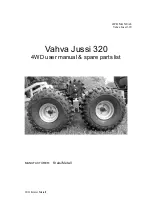
This alarm may be set to warn you when
there is only a certain amount of fuel
remaining according to the Fuel Flow
usage calculation. Pressing the “Up” or
“Down” buttons will change the Fuel
Remaining Alarm setting.
Fuel Level
The Fuel Level display shows the amount
of fuel in the fuel tank in percent of full
(PC). The indication is based on the fuel
level sender in the tank and operates
similarly to a normal fuel gauge. There are
no adjustments to this reading.
Down
Button
Up
Button
M
M
M
M
M
M
M
M
M
M
Fuel Management LCD Display Modes
Figure 1
Quick
Press
Quick
Press
Quick
Press
Quick
Press
Quick
Press
Quick
Press
Hold
Hold
Hold
Hold
Page 9
Bombardier® SystemCheck®
Description
The Bombardier SystemCheck is a system
that monitors Evinrude® and Johnson®
outboard engine sensors, providing clear
audible and visual indications whenever a
fault occurs.
The system monitors engine temperature,
oil level, oil flow, oil pressure, and fuel
restriction. In addition, the ECM (Engine
Control Module) can activate a warning
indication. Not all sensors are present on
all engines.
For information about the wiring of the
Commander to the SystemCheck harness
can be found on HN0358 in this manual.
Engine Temperature:
The displayed warning is “ENG HOT”.
Oil level:
The sensor is a mechanical float switch in
the 2 cycle oil reservoir.
The displayed warning is “LO OIL”.
Oil Flow:
Four stroke engine:
An oil pressure switch
is used.
Two stroke engine:
An oil flow sensor is
used to detect oil flow out of the oil
injection system.
The warning will be displayed as “NO OIL”.
Check Engine:
For fuel injected engines, the EMU
generates the warning based on several
fault conditions. For non-injected V6
outboard engines, a vacuum sensor is fitted
in the fuel line. This is used to detect a
blocked fuel line or fuel filter. (Non-
injected engines without the vacuum
sensor will not display this function.)
The warning will be displayed as “CHK ENG”.
Operating Modes
There are three operating modes for
SystemCheck systems, self test, normal,
and diagnostic.
Self test:
On power up (key on), a limited self-test is
performed to inform the operator that the
system is active. The test activates the
audible alarm and all warning messages.
During the self test, the audible alarm
sounds for 1/4 second. At the same time,
the unit begins displaying all of the
warning messages. Each warning message
is displayed for 1 second. When all four
messages have been displayed, the self test
is complete.
Normal mode
: This mode occurs when
two conditions are met. The self test must
be complete, and the engine must be
running in excess of 200 R.P.M. In this
mode, any fault detected will result in an
audible and visual alarm. Both will
commence simultaneously.
The audible alarm will sound for 10
seconds. The visual warning will be
displayed for as long as the fault conditions
exist.
Page 10
All manuals and user guides at all-guides.com








































